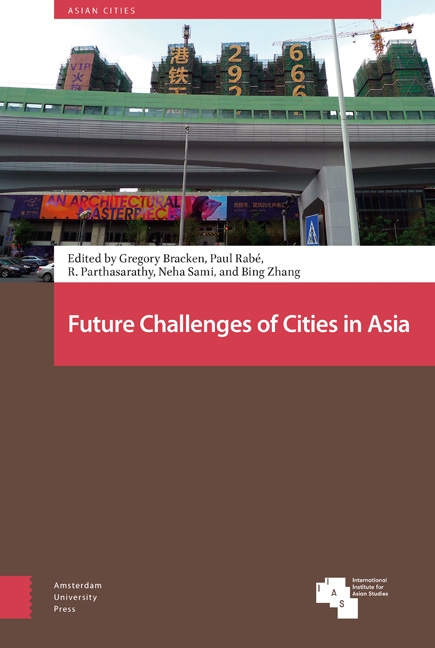Book contents
- Frontmatter
- About the Three UKNA Volumes
- Contents
- List of Figures and Tables
- 1 Future Challenges of Cities in Asia: An Introduction
- 2 Human Agency in the Asian City
- 3 Toward Inclusive, Vital and Livable City Scenarios: The Transformation of Urban Villages in Shenzhen
- 4 Cultural Dilemma in Beijing's Urban Regeneration: From Liulichang Cultural Street to Qianmen Street and Yangmeizhu Oblique Street
- 5 Housing as Heritage: The Great Urban Dilemma of the Global City of Shanghai
- 6 Not an Act of God: Lessons from a Disaster in the Settlements Planning of a River City
- 7 The Political Ecology of Climate Injustice in Bangkok
- 8 Assessing Flood-Related Vulnerability of the Urban Poor
- 9 The Ecological Future of Cities: Evaluating the Role of Green Infrastructure in Promoting Sustainability/Resilience in India
- 10 Hong Kong's “Rail-plus-Property” Development: A Model for Financing Public Transportation in Developing Cities in Southeast Asia?
- 11 Large Infrastructure Projects: The Emergence of Corridors in Asia
- Index
- Publications / Asian Cities
9 - The Ecological Future of Cities: Evaluating the Role of Green Infrastructure in Promoting Sustainability/Resilience in India
Published online by Cambridge University Press: 21 November 2020
- Frontmatter
- About the Three UKNA Volumes
- Contents
- List of Figures and Tables
- 1 Future Challenges of Cities in Asia: An Introduction
- 2 Human Agency in the Asian City
- 3 Toward Inclusive, Vital and Livable City Scenarios: The Transformation of Urban Villages in Shenzhen
- 4 Cultural Dilemma in Beijing's Urban Regeneration: From Liulichang Cultural Street to Qianmen Street and Yangmeizhu Oblique Street
- 5 Housing as Heritage: The Great Urban Dilemma of the Global City of Shanghai
- 6 Not an Act of God: Lessons from a Disaster in the Settlements Planning of a River City
- 7 The Political Ecology of Climate Injustice in Bangkok
- 8 Assessing Flood-Related Vulnerability of the Urban Poor
- 9 The Ecological Future of Cities: Evaluating the Role of Green Infrastructure in Promoting Sustainability/Resilience in India
- 10 Hong Kong's “Rail-plus-Property” Development: A Model for Financing Public Transportation in Developing Cities in Southeast Asia?
- 11 Large Infrastructure Projects: The Emergence of Corridors in Asia
- Index
- Publications / Asian Cities
Summary
Abstract
Development in India is placing excessive stresses on the ability of urban landscapes to provide sociocultural and ecological benefits. The rate of development can be seen to support economic prosperity as its primary goal, which has limited the ability of government, and the environment sector, to invest time and/or funding in green infrastructure (GI). To evaluate whether this process can be mitigated, Ahmedabad and the New Delhi National Capital Region (NCR) are discussed to establish whether an ecological networks perspective to development offers valid solutions. It proposes that an ecological networks perspective, grounded in GI theory and practice, can provide alternative investment/management mechanisms to invest in more sustainable forms of urban development.
Keywords: green infrastructure, landscape planning, urban development, city management
Introduction
The current rate of urban growth witnessed in India, approximately an 18% increase between 2001 and 2011, suggests that expansion will continue year on year (Ministry of Home Affairs 2011). As a result, each of the major urban centers of India (including the “big four” of Mumbai, New Delhi, Kolkata, and Chennai) have seen a dramatic increase in their urban composition (McKinsey Global Institute 2010). The outcome of which has been an increasing reliance on changing land use, i.e., from agricultural or open space to housing, which has, in many cases, seen the conversion of environmental resources into built infrastructure to meet transportation, commercial, and industrial land use needs.
One consequence of this process has been the downplaying of concepts such as landscape ecology, and includes a lack of reflection on the capacity of environmental resources to mitigate the fluctuating functionality of the landscape (Williams 2010). Closely tied to this process is a partial acknowledgment of how redevelopment of ecological resources into urban/ built infrastructure places additional stresses on the remaining land which may limit its ability to cope with growth (Williams 2010; Middleton and O’Keefe 2001). The efficiency of urban environments is therefore being compromised as ecological networks continue to be converted to other uses.
To address the potential impacts of a continual “graying” of the environment, Green Infrastructure (GI) planning has been proposed as offering a range of adaptive investment solutions to establish more resilient cities (Hellmund and Smith 2006).
- Type
- Chapter
- Information
- Future Challenges of Cities in Asia , pp. 209 - 242Publisher: Amsterdam University PressPrint publication year: 2019



